

 The South African
The South African
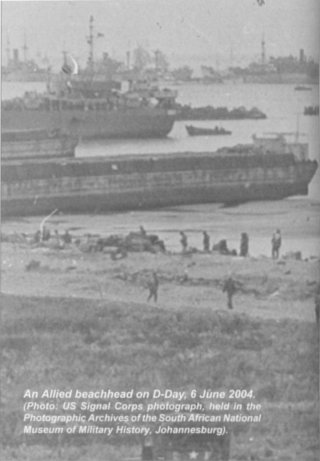
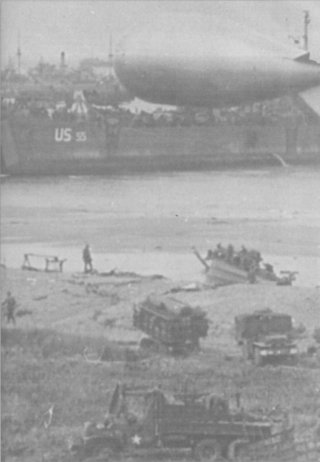
Early on, it was realised that the prelude to a successful invasion of western Europe had to be supremacy in the air and command of the Atlantic sea lanes so as to ensure the uninterrupted supply of men and war material. The latter was ensured from mid-1943, when the German Navy withdrew its U-boats from the North Atlantic in response to its unacceptable losses. Air supremacy was achieved over the winter of 1943-44 and the spring of 1944, when losses on both the eastern and western fronts left the German Luftwaffe fatally weakened. By D-Day on 6 June 1944 the Luftwaffe was unable to make any effective contribution to German resistance to the landings.
The next problem the planners faced was to choose the best places to go ashore, while concealing from the Germans where these were going to be. Four possible sites were considered. The first was southern Holland-Belgium in the area immediately south of the Scheidt Estuary. This was soon discarded. The terrain over which the invaders would have to advance was criss-crossed with countless waterways. Such country is too easy to defend. The second site to be considered was the area surrounding the mouth of the River Somme, but this, too, was considered unsuitable owing to the problems involved in maintaining contact between armies on either side of a river the bridges of which had all been destroyed.
That left Normandy and the Seine Estuary, including the land immediately to the north. This latter had the advantage that the land inshore from the coast was reasonably firm and flat, and thus suitable for advancing armour and for the building of tactical airfields. For that reason, it was the choice of the air forces and was thus much favoured by Eisenhower's British deputy, Air Chief-Marshal Sir Arthur Tedder. It was finally rejected owing to the strength of its defences, which included heavy coastal guns. The naval interests decided that the risk to shipping, carrying and supporting the invasion force would be unacceptable.
The site not considered was the most obvious one, the Pas de Calais. This portion of the French coast was, of course, the nearest to England, the distance being a mere 38km. It would have given the invasion forces the shortest sea crossing and the best possible air cover. Its disadvantage, however, was the fact that it had the heaviest fortifications of the whole French coast. Its German long-range coastal guns regularly shelled the English town of Dover and interdicted all merchant shipping activity in the Channel. Moreover, it was regarded by the German High Command as the most likely place for a landing, and the German armour was deployed accordingly. For days after the Allies had landed in Normandy, the Germans believed the main thrust would come later in the Pas de Calais.
The chief advocate of Normandy as the most suitable choice for the invasion was the man responsible for drawing up the plans. He was General Bernard Montgomery, a careful and deliberate soldier whose flair for communicating with the men under him did not extend to his fellow generals. Normandy was where the English Channel was at its widest, west of the Cherbourg Peninsula. That meant the merchant ships, the warships and the landing craft would have the furthest to travel in what could be, and did in fact turn out to be, highly unfavourable weather. The average distance was around 160km. It also meant that the air cover, mainly supplied by RAF Spitfires flying from the English south coast and operating near the limit of their endurance, would have the least time over their target areas.
[Britain's wartime Prime Minister, Winston Churchill, described the assault on Normandy on 6 June 1944 as 'the most difficult and complicated operation that has ever taken place'. He was not exaggerating. His directive to the Combined Chiefs of Staff the previous January was 'to mount and carry out an operation with forces and equipment established in the UK, and with target date 1 May 1944, to secure a lodgement on the Continent (of Europe) from which further operations could be developed .. .' Churchill's rolling phrases made it sound simple enough, although he knew it was not going to be. That it did succeed against desperate German resistance, and some of the worst weather conditions of the century, was a tribute both to the bravery and determination of those who took part in the landing, and to the expertise and competence with which Churchill's 'difficult and complicated operations' were conducted.]
Worst of all, the bocage country inland, crisscrossed by high hedges and sunken roads, was unsuited both for armoured warfare and for building airfields to accommodate the tactical aircraft so necessary to support the ground troops. This was a serious source of contention, and at one time so infuriated the airmen that Tedder urged Eisenhower to sack Montgomery. It certainly curtailed air support in the initial phases of the march inland. The problems facing the Allied armour, however, were at least partly offset by those the bocage presented for the enemy. The inability of the available German armour to reach the beachheads in time to attack the landing troops certainly helped them gain, and maintain, their early foothold.
But Montgomery saw advantages in Normandy that his colleagues did not. The beaches were good and, to some extent, sheltered from the Atlantic by the Cherbourg Peninsula. They were also the least fortified of the Channel beaches, although that did not mean their protection was anything but heavy and comprehensive. Most importantly for Montgomery, however, was the fact that he could mount a powerful defence with his British and Commonwealth forces at the extreme east of the landing area against likely German armoured counter-attacks while shielding the US force as they struck westward to capture the Cherbourg Peninsula and port. The Americans would then be able to advance unimpeded by German armour southward to the River Loire to isolate the Brittany Peninsula and its ports before turning eastward to link up with the British and Commonwealth forces on the line of the Seine. At that point it was agreed that Eisenhower should take command of the joint Allied land forces. By then the Americans would be making the main contribution to the invasion.
The landings themselves were to take place from five separate beaches. Immediately to the west of the Orne River, the British had two beaches, codenamed Sword and Gold. Between them was a beach for the Canadian forces named Juno. British airborne forces were to hold a bridgehead east of the Orne. To the west of the Commonwealth beaches were two US landing areas code-named Omaha and Utah. United States paratroops were to be landed in the marshy regions west of the Carentan River to protect the western flank of the landings. All landing areas were to be linked up, and deepened, as soon as possible so as to provide a secure lodgement area and a base for advancing inland.
It was imperative for the success of Overlord that the Allies, and especially the US forces, should, as soon as possible, have access to viable ports through which supplies and reinforcements could be unloading without having to be transhipped through Britain. During the landings, supplies would have to be shipped across open beaches. As soon as possible afterward, this method was to be supplemented by two prefabricated harbours, codenamed 'Mulberries', one for the US forces, the other for the British and Commonwealth.
These Mulberries were an extension of the outer breakwater system designed to provide an area of sheltered water at each of the five assault beaches. Each beach was to be protected by an offshore breakwater, or 'Gooseberry', formed by a total of about 70 old ships, 'Corncobs', steamed into position and sunk in line parallel to the shore. More than 200 hollow, ferro-concrete caissons built at Britain's south-coast ports were to be towed across the Channel and sunk so as to fill any gaps in the blockship line. Altogether these caissons consumed over two million tons of reinforced concrete. In addition, a pipe would be needed to carry petroleum fuel from Britain to Normandy. PLUTO (the Pipe Line Under The Ocean), proved a great success, and was later extended across the Seine to keep pace with the advancing armies.
The incredible depth and range of this logistic planning would have been of little avail without the deception plan, however. This was designed to mislead the Germans about the place and date of the proposed invasion. It was not possible to hide from them the preparations that were being made. The first part of the plan was intended to indicate that the Allied campaign would begin with the invasion of Norway. To this end, camps were set up close to several Scottish and Northern Ireland ports, where skeleton detachments maintained signs of activity for the benefit of any enemy air reconnaissance. A fictitious 'Fourth Army HQ' was set up in Scotland with appropriate wireless traffic and prepared indiscretions pointing to a Norway invasion. At one stage, Hitler considered Norway and even Denmark as possible candidates for attack, and he strengthened the defences there accordingly.
The main deception effort, however, was put into convincing German intelligence that the principal Allied landing would be made in the Pas de Calais area in the second half of July, about 45 days later than the planned D-Day. To add to information passed through spies and other underground channels, the troops located in eastern and south-eastern England were made to appear vastly more numerous by erecting dummy camps and vehicle parks, and by maintaining a high frequency of wireless traffic to and from non-existent formations. The development of roads, tracks and landing craft launching ramps was carried out openly. A US Army Group headquarters, comprising two assault armies, was set up with US General George Patton in command, and he himself was frequently seen in the area. The Germans did not seem to know that he was in disgrace at the time.
These deception operations made a considerable contribution to the success of the Normandy landings on D-Day. They were continued well into July, and Hitler went on regarding Normandy as a diversionary effort until it was too late to send effective reinforcements to its embattled defenders. When he finally did so, they marched straight into the murderous trap known to history as 'The Falaise Pocket'. There they were squeezed from the north by the British and Commonwealth armies and from the south by the US forces that had completed their move to isolate the Cherbourg and Brittany peninsulas.
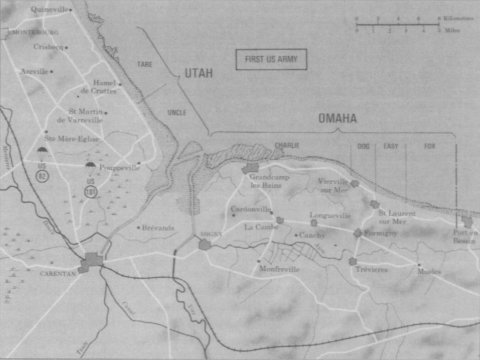
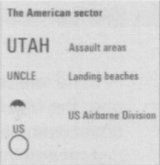
Map showing the American Sector beaches, Utah and Omaha (Belchem, 1981, p 42).
D-Day caught the Germans by surprise, although not unprepared. Their 'Western Wall' had been eighteen months in the making. It was manned by about one-fifth of the armed strength the Germans still had available after their appalling losses in Russia, although a substantial proportion were second-line or garrison troops. There were three armoured divisions under Hitler's personal orders' east of the Seine. The reason for the surprise was mainly the weather. The German High Command did not expect that the massive armada they knew to be assembled on the English south coast would venture to sea in such stormy conditions. Field Marshal Erwin Rommel, the commander of units facing the expected invasion, had taken the opportunity for a few days' leave back in Germany, while many of his senior officers were away playing war games.
The Allies had taken great care to conduct their air preparations so as to avoid giving any clue to the time and place of their landings. Round-the-clock bombing of anything likely to be of use to the German defences in the west had been going on for weeks. Thousands of tons of bombs had crippled railway junctions, destroyed fuel and ammunition dumps, and ploughed up roads, while, in daylight, fighter aircraft had strafed anything that moved within the coastal regions.
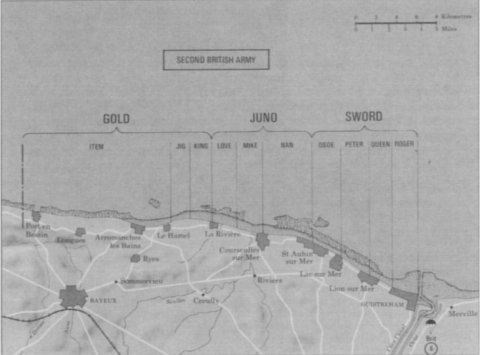
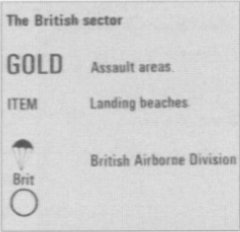
Map showing the British Commonwealrh Sector beaches, Gold, Juno and Sword (Belchem, 1981, p 43).
Altogether around 4 500 naval vessels of all kinds, including landing craft, took part in the D-Day operations. By the end of the day, they had landed a total of 75 000 British and Canadian troops and 57 500 Americans. This was about the number planned, but it was comfortably exceeded by the 112 800 British, 53 000 American and 5 000 other Allied personnel involved in the entire operation, plus the 25 000 merchant navy seamen manning the transport ships. They totalled 196 000.
There were shortfalls on delivery of supplies and equipment, however, mainly due to the difficulties experienced by the larger landing craft in navigating the beach obstacles in the sea conditions that existed on that day. These obstacles were planted in three lines, numbering about 2 500 for a typical 5km stretch of landing beach, their mass totalling 900 tons, and nearly all capped with mines or large shells.
Casualties on D-Day were mercifully light, except on Omaha Beach. They were certainly fewer than expected. Among the sea-borne troops, the British and Canadians suffered 4 200 killed, wounded and missing. The American casualty figure was around 6 000, more than half of which was accounted for at Omaha. A later estimate of the total of Allied killed on D-Day was 2500.
An operation of the size and complexity of the D-Day landings was bound to evoke numerous controversies, and what happened in the subsequent breakout and full-scale invasion produced even more. These are still being debated by military historians and the dwindling numbers of those who took part, but despite all the problems that arose and the disputes that followed, D-Day was a success. The Allies achieved their overall objective of invading western Europe and defeating their enemy. The extended period of planning and preparation paid off in the end.
It was providential for both sides that they did indeed payoff. If the Allies had failed, the blow to their morale would have been little short of disastrous. It could have taken years before they were able to accumulate the strength to try again. Meanwhile, London would have suffered prolonged bombardment by the new V1 rockets, while the end of the immediate threat from the west might well have enabled the Germans to hold the Russian advance long enough to persuade Stalin it was worth his while to conclude a separate peace. For the Germans, of course, their defeat by conventional arms doubtless saved Berlin and other major cities from being the first targets of the new nuclear weapons which entered the war the following year. In retrospect, the success of D-Day was the best possible outcome.
Bibliography
Belchem, D, Victory in Normandy (Book Club Associates, London, 1981).
Hamilton, N, Monty: Master of the Battlefield Vol 2 (Sceptre, Hodder & Stoughton, 1987).
Hastings, M, Overlord: D-Day and the Battle for Normandy (Michael Joseph, London, 1984).
Holmes, R, The D-Day Experience: The invasion to the Liberation of Paris (Carlton Books, in association with the Imperial War Museum).
Horne, A, and Montgomery, D, Monty, 1944-1945: The Lonely Leader (Macmillan, London, 1994).
Liddell Hart, Sir B, History of the Second World War (Cassel, London, 1970).
Wilmot, C, The Struggle for Europe (Collins, London, 1952).
Return to Journal Index OR Society's Home page
South African Military History Society / scribe@samilitaryhistory.org